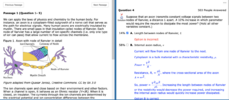So I know there are several versions of the equation for Power in circuits, based on how you interconvert Ohm's law V=IR. I got the reference here:
However I'm a bit confused about these 2 versions. In one, power is directly proportional to resistance, and in the other, it's inversely proportional. How is this possible? P=I^2*R vs. P=V^2/R
Most importantly, what kind of clue can I use when reading a question on the MCAT to know when to use which equation? For example, in Question 4 of this Khan Academy passage, is there a specific reason why they use P=V^2/R?
Here is a screen shot of it. Thank you so much!
However I'm a bit confused about these 2 versions. In one, power is directly proportional to resistance, and in the other, it's inversely proportional. How is this possible? P=I^2*R vs. P=V^2/R
Most importantly, what kind of clue can I use when reading a question on the MCAT to know when to use which equation? For example, in Question 4 of this Khan Academy passage, is there a specific reason why they use P=V^2/R?
Here is a screen shot of it. Thank you so much!

